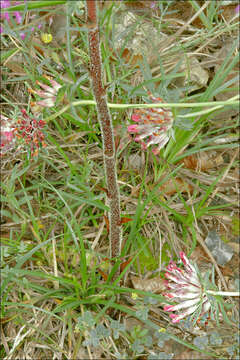Orobanche-minor_5

Description:
Orobanche minor Sm., syn.: Orobanche langei Huter, Porta & Rigo, Orobanche major f. hypochoeridis Beck, Orobanche maritima Pugsley, Orobanche salisii Req. ex Coss. and about 25 other names.Family: Orobanchaceae Vent.EN: Lesser broomrape, Common broomrape, DE: Kleine Sommerwurz, Klee-WrgerSlo.: mali pojalnik Dat.: May 04. 2019Lat.: 45.07642 Long.: 14.43666Code: Bot_1191/2019_DSC5058Habitat: garrigue, moderately inclined hill slope, west aspect; dry, warm, mostly sunny place; calcareous, skeletal ground; exposed to direct rain; elevation 65 m (210 feet); average precipitations ~ 1.000 mm/year, average temperature 12-14 deg C, Sub-Mediterranean phytogeographical region. Substratum: soil.Place: Adriatic Sea, island Krk, next to the trail leading west from village Brzac (old part) to the sea shore, Kvarner archipelago, Rijeka region, Croatia. Comment (pertains to pictures in the Flickr album Orobanche minor): Orobanche minor is a widespread and quite common holoparasitic species (those that lost all the photosynthetic properties). It is present almost in all European countries (exceptions are Scandinavia and most-northeast countries), in Mediterranean countries of North Africa, in parts of Asia Minor and from Macaronesia to Arabian Peninsula and S. Tropical Africa (Ref.: 4.). Today it is introduced also to other continents. Generally, to recognize plants belonging to genus Orobanche is easy. These attractive plants are strange looking, with very specific habit and flowers. However, on species level the situation is much more challenging. The reasons are several. Plants are notoriously variable in shape, color and size, they change radically their shape during anthese, they are difficult to study since they lose their colors in herbariums. Hundreds of varieties and forms have been described. 'Total' number of taxa in the genus varies enormously among different authors depending on their taxonomical approach. For some species there is still no agreement on the taxonomy. Consider this: length of corolla of Orobanche minor is described in Ref.: 2. as 10-12(15) mm long, in Ref. 1. as 6-10 mm, in Ref.: 3. as 10-19 mm and as 6-10 mm for one of its varieties (Orobanche minor var. maritima). This find corresponds well to the characteristics traits of Orobanche minor as described in Ref.: 3.. The solitary plant is relatively small, slender, strongly glandular-pubescent and of 'proper' color (that means most common color). The calyx segments are unequally bidentate and almost filiform at the tip, the bracts are almost as long as corolla, corollas have distinct violet veins on pale-whitish-yellowish background, the upper lip is almost entire, the lower lip is tripartite consisting of unevenly crenate lobes of approximately equal size and the stigma is brown-violet. The plant parasites on many species of several genera, most often on clovers (Trifolium) but also on other legumes, peas and beans (Fabaceae) and composites (Asteraceae). In this find it parasitized Anthyllis vulneraria ssp. rubiflora. Its withered flowers can be seen on Fig. 5.Ref.:(1) M. Blamey, C. Grey-Wilson, Wild Flowers of the Mediterranean, A & C Black, London (2005), p 417.(2) A. Martini et all., Mala Flora Slovenije (Flora of Slovenia - Key) (in Slovenian), Tehnina Zaloba Slovenije (2007), p 578. (3) C.A.J. Kreutz, Orobanche, The European broomrape species, Vol.1., Central and Northern Europe, Stichting Natuurpublicaties Limburg, Maastrich (1995), p 120.(4) powo.science.kew.org/taxon/urn:lsid:ipni.org:names:53607-3 (accessed Jan. 22. 2023)
Included On The Following Pages:
- Life (creatures)
- Cellular (cellular organisms)
- Eukaryota (eukaryotes)
- Archaeplastida (plants)
- Chloroplastida (green plants)
- Streptophyta
- Embryophytes
- Tracheophyta (ferns)
- Spermatophytes (seed plants)
- Angiosperms (Dicotyledons)
- Eudicots
- Superasterids
- Asterids
- Lamiales ("An Order: Mints, Vervains, Snapdragons, Etc.")
- Orobanchaceae (broomrape family)
- Orobanche (broomrape)
- Orobanche minor (clover broomrape)
This image is not featured in any collections.
Source Information
- license
- cc-by-nc-sa
- copyright
- Amadej Trnkoczy
- photographer
- Amadej Trnkoczy
- original
- original media file
- visit source
- partner site
- Flickr Group
- ID


